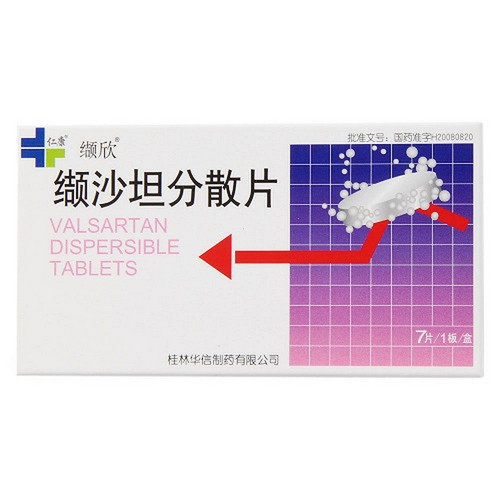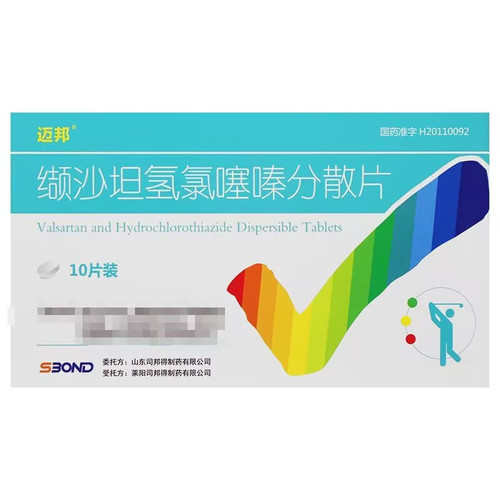Product Overview
[Drug Name]
Generic Name: Valsartan Dispersible Tablets
Trade Name: Huanglong/Yidaler
English Name: Valsartan Dispersible Tablets
Chinese Pinyin: Xiashatan Fensanpian
[Ingredients]
Valsartan
[Properties]
This product is a white tablet.
[Indications]
For the treatment of mild to moderate essential hypertension.
[Dosage and Administration]
Recommended dose: 80 mg once daily. Dosage is not related to race, age, or gender. It can be taken with or without food (see Absorption). It is recommended to take the drug at the same time each day (e.g., in the morning). A definitive antihypertensive effect is achieved within two weeks, and maximum efficacy is achieved after four weeks. If the antihypertensive effect is unsatisfactory, the daily dose can be increased to 160 mg, or a diuretic can be added. No dose adjustment is required for patients with renal impairment (contraindicated for severe renal failure) or non-biliary, non-choledostatic hepatic insufficiency. Valsartan can be used in combination with other antihypertensive drugs.
[Adverse Reactions]
The overall incidence of adverse reactions with this drug is similar to that observed with placebo. The main adverse reactions observed in clinical use include headache, dizziness, viral infections, upper respiratory tract infections, cough, diarrhea, fatigue, rhinitis, back pain, nausea, pharyngitis, and arthralgia. The incidence of adverse reactions is not related to dose or duration of treatment, nor to gender, age, or race. It is unknown whether these reactions are causally related to treatment with this drug. Laboratory Indicators: This drug may occasionally cause a decrease in hemoglobin and hematocrit. In controlled clinical trials, patients taking this drug experienced significant decreases in hematocrit and hemoglobin, with 0.8% and 0.4% of patients, respectively, compared to 0.1% in the placebo group. Neutropenia occurred in 1.9% of patients taking this drug and 1.8% of patients taking ACE inhibitors, respectively.
[Contraindications]
This drug is contraindicated in patients with known hypersensitivity to it. It is contraindicated in pregnant and lactating women.
[Precautions]
1. Hyponatremia and/or Hypovolemia: In rare cases, patients with severe sodium deficiency and/or hypovolemia (e.g., those taking high-dose diuretics) may experience symptomatic hypotension when starting treatment with this drug. Correction of hyponatremia and/or hypovolemia, or reduction of the diuretic dose, should be performed before starting treatment. If hypotension occurs, the patient should be placed in a supine position and, if necessary, intravenous saline infusion should be administered. Treatment with this drug should be resumed after blood pressure stabilizes. 2. Renal Artery Stenosis: In 12 patients with secondary renovascular hypertension due to unilateral renal artery stenosis, 4-day use of this drug did not result in significant changes in renal hemodynamics, creatinine, or blood urea nitrogen (BUN). Because other drugs that act on the RAAS may increase BUN and creatinine in patients with unilateral or bilateral renal artery stenosis, monitoring is recommended to ensure safety.
[Use in Special Populations]
Precautions for Pediatric Use: The efficacy and safety of this drug in children have not been studied. There is no experience with its use in children.
Pregnancy and Lactation Precautions: Early pregnancy (first trimester): Pregnancy Category B. Animal studies have shown no fetal harm. Mid- and late-term pregnancy (second and third trimesters): Pregnancy Category D. There is evidence of fetal harm in humans, but the benefits outweigh the risks. Given the mechanism of action of angiotensin II receptor antagonists, fetal harm cannot be ruled out. Drugs directly acting on the RAAS during mid- and late pregnancy can cause fetal harm or death. Renal perfusion begins in the second trimester, and this is dependent on the development of the RAAS system. Therefore, the risk is increased during mid- and late-term use of this drug. Similar to other drugs directly acting on the RAAS, this drug is not recommended for use during pregnancy. If pregnancy is discovered during treatment, valsartan should be discontinued as soon as possible. All newborns exposed to the drug in utero should be closely monitored to ensure adequate urine output, prevent hyperkalemia, and monitor blood pressure. If necessary, appropriate treatment measures (such as rehydration) should be implemented to remove the drug. Valsartan is excreted in rabbit milk. Currently, no studies have been conducted on lactating women, so this product is not recommended for use during lactation.
Precautions for Elderly Patients:
Although systemic exposure to valsartan is slightly higher in the elderly than in younger patients, this is not clinically significant.
[Drug Interactions]
No significant drug interactions have been observed clinically. Studies have been conducted with the following drugs: cimetidine, warfarin, furosemide, digoxin, atenolol, indomethacin, hydrochlorothiazide, amlodipine, and glyburide. Because valsartan undergoes minimal metabolism, no clinical interactions with drugs that induce or inhibit the cytochrome P450 system have been observed. Although valsartan is largely bound to plasma proteins, in vitro studies have not demonstrated interactions with other plasma protein-bound drugs (such as diclofenac, furosemide, and warfarin) at this level. When coadministered with potassium-sparing diuretics (such as spironolactone, triamterene, and amiloride), potassium supplementation or the use of potassium-containing preparations may increase serum potassium levels. Therefore, caution is advised when administering these drugs together.
[Pharmacological Action]
Mechanism of Action: 1. Angiotensin II is the activator of the renin-angiotensin-aldosterone system (RAAS), which is formed from angiotensin I through the action of angiotensin-converting enzyme (ACE). Angiotensin II binds to specific receptors on the cell membranes of various tissues. It has multiple physiological effects, including direct and indirect involvement in blood pressure regulation. Angiotensin II is a potent vasoconstrictor with a direct pressor effect. It also promotes sodium reabsorption and stimulates aldosterone secretion. 2. Valsartan is an orally active, specific angiotensin (AT) II receptor antagonist. It selectively targets the AT1 receptor subtype, producing all known effects. The AT2 receptor subtype is not involved in cardiovascular effects. Valsartan has no partial agonist activity at the AT1 receptor. Valsartan has a 20,000-fold stronger affinity for the AT1 receptor than for the AT2 receptor. 3. ACE converts angiotensin I to angiotensin II, which degrades bradykinin. Valsartan, an angiotensin II receptor antagonist, does not inhibit ACE and does not cause bradykinin or substance P retention, thus not causing cough. Clinical trials comparing valsartan with ACE inhibitors demonstrated a significantly lower incidence of dry cough in the valsartan group (2.6%) compared to the ACE inhibitor group (7.9%) (P < 0.05). In a clinical trial of patients who developed dry cough after receiving ACE inhibitors, cough was reported in 19.5% of the valsartan group, 19.0% of the diuretic group, and 68.5% of the ACE inhibitor group (P < 0.05). Valsartan has no effect on other hormone receptors or ion channels known to play an important role in cardiovascular regulation. Efficacy: Valsartan lowers elevated blood pressure without affecting heart rate. In most patients, a single oral dose produces a blood pressure-lowering effect within 2 hours, reaching peak effect 4-6 hours after administration, and maintaining the antihypertensive effect for at least 24 hours after dosing. Maximum antihypertensive efficacy is achieved after 2-4 weeks of treatment and is maintained during long-term treatment. Combination with thiazide diuretics can further significantly enhance the antihypertensive effect. Sudden discontinuation of valsartan treatment does not cause rebound hypertension or other side effects. 5. Valsartan does not affect total cholesterol, triglyceride, blood glucose, or uric acid levels in hypertensive patients.
[Storage] Store tightly closed.
[Specification] 80mg x 7 tablets
[Packaging] Box
[Expiry Date] 24 months
[Approval Number] National Medicine Standard H20050508
[Manufacturer] Company Name: Hainan Huanglong Pharmaceutical Co., Ltd.








